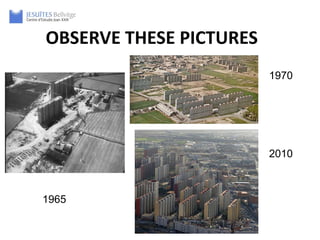Population
•
0 gostou•460 visualizações
Denunciar
Compartilhar
Denunciar
Compartilhar
Baixar para ler offline

Recomendados
Mais conteúdo relacionado
Destaque
Destaque (7)
Korišćenje slobodnog vremena u funkciji volontiranja

Korišćenje slobodnog vremena u funkciji volontiranja
Semelhante a Population
Semelhante a Population (20)
The world population distribution, density and growth

The world population distribution, density and growth
Último
https://app.box.com/s/z2cfx5b2yooxq1ov1wrd1dezn6af36uxBỘ LUYỆN NGHE TIẾNG ANH 8 GLOBAL SUCCESS CẢ NĂM (GỒM 12 UNITS, MỖI UNIT GỒM 3...

BỘ LUYỆN NGHE TIẾNG ANH 8 GLOBAL SUCCESS CẢ NĂM (GỒM 12 UNITS, MỖI UNIT GỒM 3...Nguyen Thanh Tu Collection
Último (20)
Basic Civil Engg Notes_Chapter-6_Environment Pollution & Engineering

Basic Civil Engg Notes_Chapter-6_Environment Pollution & Engineering
The Ultimate Guide to Social Media Marketing in 2024.pdf

The Ultimate Guide to Social Media Marketing in 2024.pdf
BỘ LUYỆN NGHE TIẾNG ANH 8 GLOBAL SUCCESS CẢ NĂM (GỒM 12 UNITS, MỖI UNIT GỒM 3...

BỘ LUYỆN NGHE TIẾNG ANH 8 GLOBAL SUCCESS CẢ NĂM (GỒM 12 UNITS, MỖI UNIT GỒM 3...
slides CapTechTalks Webinar May 2024 Alexander Perry.pptx

slides CapTechTalks Webinar May 2024 Alexander Perry.pptx
Removal Strategy _ FEFO _ Working with Perishable Products in Odoo 17

Removal Strategy _ FEFO _ Working with Perishable Products in Odoo 17
Essential Safety precautions during monsoon season

Essential Safety precautions during monsoon season
Post Exam Fun(da) Intra UEM General Quiz 2024 - Prelims q&a.pdf

Post Exam Fun(da) Intra UEM General Quiz 2024 - Prelims q&a.pdf
ppt your views.ppt your views of your college in your eyes

ppt your views.ppt your views of your college in your eyes
Danh sách HSG Bộ môn cấp trường - Cấp THPT.pdf

Danh sách HSG Bộ môn cấp trường - Cấp THPT.pdf
Population
- 1. OBSERVE THESE PICTURES 1970 2010 1965 2012
- 2. 1970-1980
- 3. 2012
- 4. YOUR SCHOOL!! 1968 1977 2010
- 5. POPULATION POPULATION: Number of people who live in an area. There are different ways to classify the population ECONOMIC AGE LOCATION ACTIVITY
- 6. AGE We can classify the population by age Young people Adults Seniors Children and people who are people who are adolescents sixteen to sixty- sixty-five or older (< 18) four ( 16-64) (>65)
- 7. LOCATION There are two types of population: Rural populations Urban populations People live in small People live in large villages or towns cities
- 8. ECONOMIC ACTIVITY We can classify the population by economic activity: Active Population Inactive Population People work and earn a People don´t work and don´t salary. earn a salary (not legal People who are unemployed working age, people who are but they are looking for a job. ill and so on).
- 9. POPULATION CHANGES The number of inhabitants in a place changes continually. Some people: are born die and arrive or leave to another countries.. • Census is a survey of all the people in the country.
- 10. If we look at the birth rates, the death rates and the inmigration and emigration we will see that the population can increase or can decrease. Positive natural increase Negative natural increase More people are born than More people died that are die. The population grows. born. The population decreases.
- 11. MIGRATION There are people who leave their homes to live in another place. This is called migration Why do they leave their homes? Natural causes: Floods, Social factors: War, political earthquakes, droughts and religious problems or some problems to find a job.
- 12. TYPES OF MIGRATION Internal migration: People leave their homes within the same country. Why people leave their homes? The number of jobs in rural areas decreases. Young people find better opportunities to study, work and live in cities.
- 13. International migration: people migrate from one country to another
- 14. WHAT´S THE DIFFERENCE? – Emigrants: People who leave a country. – Immigrants: People who arrive in another country.
- 15. POPULATION DISTRIBUTION Some countries and regions are more populated than others because of job opportunities, a healthy climate and good services.
- 16. Population density shows us how populated an area is. We calculate the population density by dividing the total number of inhabitants by the size of the area they live in. High population density Low population density